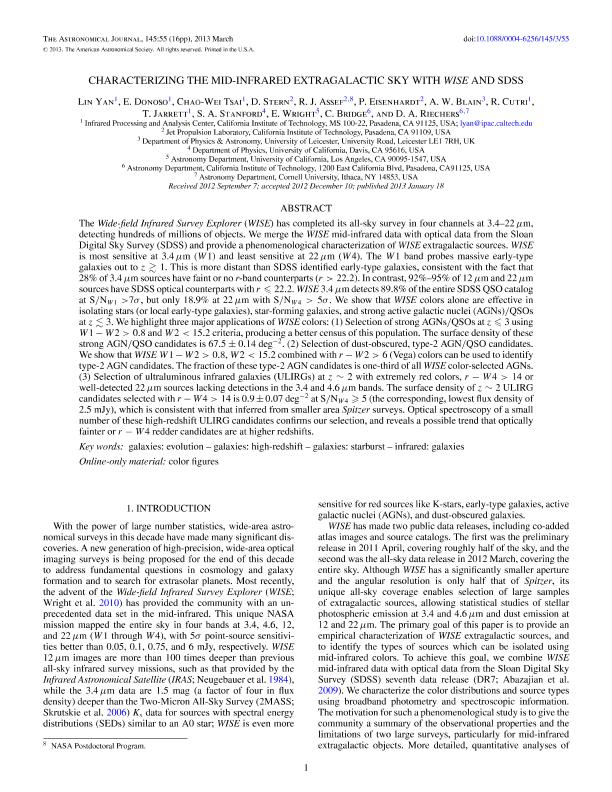Mostrar el registro sencillo del ítem
dc.contributor.author
Yan, L.
dc.contributor.author
Donoso, Emilio

dc.contributor.author
Tsai, Chao Wei
dc.contributor.author
Stern, D.
dc.contributor.author
Assef, R. J.
dc.contributor.author
Eisenhardt, P.
dc.contributor.author
Blain, A. W.
dc.contributor.author
Cutri, R.
dc.contributor.author
Jarrett, T. H.
dc.contributor.author
Stanford, S. A.
dc.contributor.author
Wright, E.
dc.contributor.author
Bridge, C.
dc.contributor.author
Riechers, D. A.
dc.date.available
2015-08-12T15:32:59Z
dc.date.issued
2013-03-18
dc.identifier.citation
Yan, L.; Donoso, Emilio; Tsai, Chao Wei; Stern, D.; Assef, R. J.; et al.; Characterizing the Mid-infrared Extragalactic Sky with WISE and SDSS; American Astronomical Society; Astronomical Journal; 145; 5; 18-3-2013; 1-16
dc.identifier.issn
0004-6256
dc.identifier.uri
http://hdl.handle.net/11336/1643
dc.description.abstract
The Wide-field Infrared Survey Explorer (WISE) has completed its all-sky survey in four channels at 3.4–22um, detecting hundreds of millions of objects. We merge the WISE mid-infrared data with optical data from the Sloan Digital Sky Survey (SDSS) and provide a phenomenological characterization of WISE extragalactic sources. WISE is most sensitive at 3.4um (W1) and least sensitive at 22um (W4). The W1 band probes massive early-type galaxies out to z~1. This is more distant than SDSS identified early-type galaxies, consistent with the fact that 28% of 3.4um sources have faint or no r-band counterparts (r > 22.2). In contrast, 92%–95% of 12um and 22um sources have SDSS optical counterparts with r<22.2. WISE 3.4um detects 89.8% of the entire SDSS QSO catalog at S/N W1 >7σ, but only 18.9% at 22um with S/N W4 > 5 sigma. We show that WISE colors alone are effective in isolating stars (or local early-type galaxies), star-forming galaxies, and strong active galactic nuclei (AGNs)/QSOs at z~3. We highlight three major applications of WISE colors: (1) Selection of strong AGNs/QSOs at z~3 using W1−W2>0.8 and W2<15.2 criteria, producing a better census of this population. The surface density of these strong AGN/QSO candidates is 67.5$pm$0.14 deg^−2 . (2) Selection of dust-obscured, type-2 AGN/QSO candidates. We show that WISE W1−W2>0.8, W2 < 15.2 combined with r−W2>6 (Vega) colors can be used to identify type-2 AGN candidates. The fraction of these type-2 AGN candidates is one-third of all WISE color-selected AGNs. (3) Selection of ultraluminous infrared galaxies (ULIRGs) at z∼2 with extremely red colors, r − W4 > 14 or well-detected 22um sources lacking detections in the 3.4 and 4.6um bands. The surface density of z∼2 ULIRG candidates selected with r −W4 > 14 is 0.9$pm$0.07 deg−2 at S/N W4~5 (the corresponding, lowest flux density of 2.5 mJy), which is consistent with that inferred from smaller area Spitzer surveys. Optical spectroscopy of a small number of these high-redshift ULIRG candidates confirms our selection, and reveals a possible trend that optically fainter or r−W4 redder candidates are at higher redshifts.
dc.format
application/pdf
dc.language.iso
eng
dc.publisher
American Astronomical Society
dc.rights
info:eu-repo/semantics/openAccess
dc.rights.uri
https://creativecommons.org/licenses/by-nc-sa/2.5/ar/
dc.subject
Galaxies Evolution
dc.subject
Galaxies High-Redshift
dc.subject
Galaxies Starburst
dc.subject
Infrared Galaxies
dc.subject.classification
Astronomía

dc.subject.classification
Ciencias Físicas

dc.subject.classification
CIENCIAS NATURALES Y EXACTAS

dc.title
Characterizing the Mid-infrared Extragalactic Sky with WISE and SDSS
dc.type
info:eu-repo/semantics/article
dc.type
info:ar-repo/semantics/artículo
dc.type
info:eu-repo/semantics/publishedVersion
dc.date.updated
2016-03-30 10:35:44.97925-03
dc.journal.volume
145
dc.journal.number
5
dc.journal.pagination
1-16
dc.journal.pais
Estados Unidos

dc.journal.ciudad
Washington
dc.conicet.avisoEditorial
©2013. The American Astronomical Society. All rights reserved.
dc.description.fil
Fil: Yan, L.. California Institute of Technology. Infrared Processing and Analysis Center; Estados Unidos;
dc.description.fil
Fil: Donoso, Emilio. California Institute of Technology. Infrared Processing and Analysis Center; Estados Unidos; . Consejo Nacional de Investigaciones Científicas y Técnicas. Centro Cientifico Tecnológico - CONICET - San Juan. Instituto de Ciencias Astronómicas de la Tierra y del Espacio; Argentina
dc.description.fil
Fil: Tsai, Chao Wei. California Institute of Technology. Infrared Processing and Analysis Center; Estados Unidos;
dc.description.fil
Fil: Stern, D.. California Institute of Technology. Jet Propulsion Laboratory; Estados Unidos;
dc.description.fil
Fil: Assef, R. J.. California Institute of Technology. Jet Propulsion Laboratory; Estados Unidos;
dc.description.fil
Fil: Eisenhardt, P.. California Institute of Technology. Jet Propulsion Laboratory; Estados Unidos;
dc.description.fil
Fil: Blain, A. W.. University of Leicester. Department of Physics & Astronomy; Reino Unido;
dc.description.fil
Fil: Cutri, R.. California Institute of Technology. Infrared Processing and Analysis Center; Estados Unidos;
dc.description.fil
Fil: Jarrett, T. H.. California Institute of Technology. Infrared Processing and Analysis Center; Estados Unidos;
dc.description.fil
Fil: Stanford, S. A.. University of California. Department of Physics; Estados Unidos;
dc.description.fil
Fil: Wright, E.. University of California. Astronomy Department; Estados Unidos;
dc.description.fil
Fil: Bridge, C.. California Institute of Technology. Astronomy Department; Estados Unidos;
dc.description.fil
Fil: Riechers, D. A.. California Institute of Technology. Astronomy Department; Estados Unidos; . Cornell University. Astronomy Department; Estados Unidos;
dc.journal.title
Astronomical Journal

dc.relation.alternativeid
info:eu-repo/semantics/altIdentifier/url/http://iopscience.iop.org/1538-3881/145/3/55/pdf/1538-3881_145_3_55.pdf
dc.relation.alternativeid
info:eu-repo/semantics/altIdentifier/doi/http://dx.doi.org/10.1088/0004-6256/145/3/55
Archivos asociados
